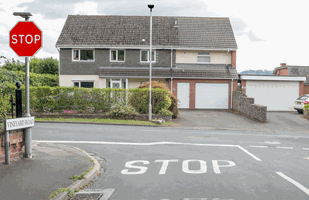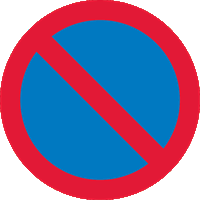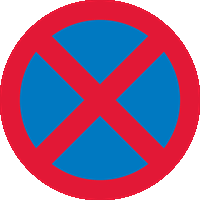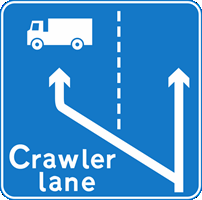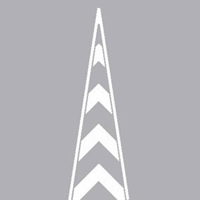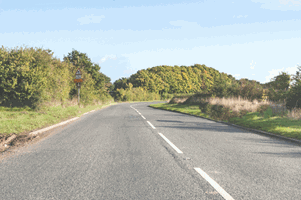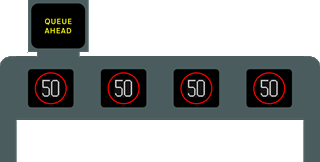You have 57 minutes to answer 50 multiple choice theory test questions. You need to answer at least 43 out of 50 questions correctly to pass. You can review your answer after each question or you can review all of your answers at the end of the test. Best of luck!
Test Quick View
Click on an answer to view the correct choice along with the explanation.
Correct Answer: A
Explanation: Your horn must not be used between 11.30 pm and 7 am in a built-up area or when you are stationary, unless a moving vehicle poses a danger. Its function is to alert other road users to your presence.
Explanation: Your horn must not be used between 11.30 pm and 7 am in a built-up area or when you are stationary, unless a moving vehicle poses a danger. Its function is to alert other road users to your presence.
2. Freezing conditions will affect the distance it takes you to come to a stop. You should expect stopping distances to increase by up to
Mark one answer
B
C
D
Correct Answer: B
Explanation: Your tyre grip is greatly reduced on icy roads and you need to allow up to ten times the normal stopping distance.
Explanation: Your tyre grip is greatly reduced on icy roads and you need to allow up to ten times the normal stopping distance.
Correct Answer: B
Explanation: Look at the picture carefully and try to imagine you're there. The cyclist in this picture appears to be trying to cross the road. You must be able to deal with the unexpected, especially when you're approaching a hazardous junction. Look well ahead to give yourself time to deal with any hazards.
Explanation: Look at the picture carefully and try to imagine you're there. The cyclist in this picture appears to be trying to cross the road. You must be able to deal with the unexpected, especially when you're approaching a hazardous junction. Look well ahead to give yourself time to deal with any hazards.
Correct Answer: A
Explanation: The 'stop' sign has been put here because there is a poor view into the main road. You must stop because it will not be possible to assess the situation on the move, however slowly you are travelling.
Explanation: The 'stop' sign has been put here because there is a poor view into the main road. You must stop because it will not be possible to assess the situation on the move, however slowly you are travelling.
5. You are approaching a roundabout. There are horses just ahead of you. You should
Mark two answers
B
C
D
E
Correct Answer: B, C
Explanation: Horse riders often keep to the outside of the roundabout even if they are turning right. Give them plenty of room and remember that they may have to cross lanes of traffic.
Explanation: Horse riders often keep to the outside of the roundabout even if they are turning right. Give them plenty of room and remember that they may have to cross lanes of traffic.
Correct Answer: D
Explanation: There will be a plate or additional sign to tell you when the restrictions apply.
Explanation: There will be a plate or additional sign to tell you when the restrictions apply.
Correct Answer: C
Explanation: Clearways are stretches of road where you aren't allowed to stop unless in an emergency. You'll see this sign. Stopping where these restrictions apply may be dangerous and likely to cause an obstruction. Restrictions might apply for several miles and this may be indicated on the sign.
Explanation: Clearways are stretches of road where you aren't allowed to stop unless in an emergency. You'll see this sign. Stopping where these restrictions apply may be dangerous and likely to cause an obstruction. Restrictions might apply for several miles and this may be indicated on the sign.
Correct Answer: A
Explanation: You will not be able to find a through route to another road. Use this road only for access.
Explanation: You will not be able to find a through route to another road. Use this road only for access.
Correct Answer: B
Explanation: Where there's a long, steep, uphill gradient on a motorway, a crawler lane may be provided. This helps the traffic to flow by diverting the slower heavy vehicles into a dedicated lane on the left.
Explanation: Where there's a long, steep, uphill gradient on a motorway, a crawler lane may be provided. This helps the traffic to flow by diverting the slower heavy vehicles into a dedicated lane on the left.
10. You are at a junction controlled by traffic lights. When should you NOT proceed at green?
Mark one answer

B
C
D
Correct Answer: D
Explanation: As you approach the lights look into the road you wish to take. Only proceed if your exit road is clear. If the road is blocked hold back, even if you have to wait for the next green signal.
Explanation: As you approach the lights look into the road you wish to take. Only proceed if your exit road is clear. If the road is blocked hold back, even if you have to wait for the next green signal.
Correct Answer: C
Explanation: When driving on a motorway or slip road, you must not enter into an area marked with chevrons and bordered by a solid white line for any reason, except in an emergency.
Explanation: When driving on a motorway or slip road, you must not enter into an area marked with chevrons and bordered by a solid white line for any reason, except in an emergency.
12. When approaching a right-hand bend you should keep well to the left. Why is this?
Mark one answer
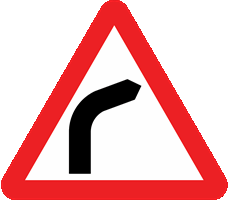
B
C
D
Correct Answer: B
Explanation: Doing this will give you an earlier view around the bend and enable you to see any hazards sooner.It also reduces the risk of collision with an oncoming vehicle that may have drifted over the centre line while taking the bend.
Explanation: Doing this will give you an earlier view around the bend and enable you to see any hazards sooner.It also reduces the risk of collision with an oncoming vehicle that may have drifted over the centre line while taking the bend.
Correct Answer: C
Explanation: The centre of the road is usually marked by a broken white line, with lines that are shorter than the gaps. When the lines become longer than the gaps this is a hazard warning line. Look well ahead for these, especially when you are planning to overtake or turn off.
Explanation: The centre of the road is usually marked by a broken white line, with lines that are shorter than the gaps. When the lines become longer than the gaps this is a hazard warning line. Look well ahead for these, especially when you are planning to overtake or turn off.
B
C
D
E
Correct Answer: B, E
Explanation: If you accumulate six or more penalty points within two years of gaining your first full licence it will be revoked. The six or more points include any gained due to offences you committed before passing your test. If this happens you may only drive as a learner until you pass both the theory and practical tests again.
Explanation: If you accumulate six or more penalty points within two years of gaining your first full licence it will be revoked. The six or more points include any gained due to offences you committed before passing your test. If this happens you may only drive as a learner until you pass both the theory and practical tests again.
15. Ahead of you there is a moving vehicle with a flashing amber beacon. This means it is
Mark one answer
B
C
D
Correct Answer: D
Explanation: As you approach the vehicle, assess the situation. Due to its slow progress you will need to judge whether it is safe to overtake.
Explanation: As you approach the vehicle, assess the situation. Due to its slow progress you will need to judge whether it is safe to overtake.
Correct Answer: A
Explanation: If you're following a large vehicle but are so close to it that you can't see the exterior mirrors, the driver can't see you.Keeping well back will also allow you to see the road ahead by looking past either side of the large vehicle.
Explanation: If you're following a large vehicle but are so close to it that you can't see the exterior mirrors, the driver can't see you.Keeping well back will also allow you to see the road ahead by looking past either side of the large vehicle.
17. You are in the right-hand lane on a motorway. You see these overhead signs. This means
Mark one answer

B
C
D
Correct Answer: B
Explanation: You MUST obey this sign. There might not be any visible signs of a problem ahead. However, there might be queuing traffic or another hazard which you cannot yet see.
Explanation: You MUST obey this sign. There might not be any visible signs of a problem ahead. However, there might be queuing traffic or another hazard which you cannot yet see.
Correct Answer: A
Explanation: If you want to keep a vehicle off the public road you must declare SORN. It is an offence not to do so. You then won't have to pay road tax for that vehicle. You will incur a penalty after 12 months if you don't renew the SORN declaration, or re-license the vehicle. If you sell the vehicle the SORN declaration ends and the new owner should declare SORN or re-license the vehicle.
Explanation: If you want to keep a vehicle off the public road you must declare SORN. It is an offence not to do so. You then won't have to pay road tax for that vehicle. You will incur a penalty after 12 months if you don't renew the SORN declaration, or re-license the vehicle. If you sell the vehicle the SORN declaration ends and the new owner should declare SORN or re-license the vehicle.
Correct Answer: D
Explanation: You MUST use parking lights when parking at night on a road or lay-by with a speed limit greater than 30 mph. You MUST also park in the direction of the traffic flow and not close to a junction
Explanation: You MUST use parking lights when parking at night on a road or lay-by with a speed limit greater than 30 mph. You MUST also park in the direction of the traffic flow and not close to a junction
Correct Answer: C
Explanation: If you have to leave your vehicle in a tunnel and leave by an emergency exit, do so as quickly as you can. Follow the signs directing you to the nearest exit point. If there are several people using the exit, don't panic but try to leave in a calm and orderly manner.
Explanation: If you have to leave your vehicle in a tunnel and leave by an emergency exit, do so as quickly as you can. Follow the signs directing you to the nearest exit point. If there are several people using the exit, don't panic but try to leave in a calm and orderly manner.
Correct Answer: A
Explanation: Mandatory speed limit signs above all lanes including the hard shoulder, show that you are in an Active Traffic Management (ATM) area. In this case you can use the hard shoulder as a running lane. You must stay within the speed limit shown. Look out for any vehicles that may have broken down and be blocking the hard shoulder.
Explanation: Mandatory speed limit signs above all lanes including the hard shoulder, show that you are in an Active Traffic Management (ATM) area. In this case you can use the hard shoulder as a running lane. You must stay within the speed limit shown. Look out for any vehicles that may have broken down and be blocking the hard shoulder.
Correct Answer: D
Explanation: Your vehicle MUST have valid insurance cover before you can tax it. If required, it will also need to have a valid MOT certificate. You can tax your vehicle online, by phone or at certain post offices.
Explanation: Your vehicle MUST have valid insurance cover before you can tax it. If required, it will also need to have a valid MOT certificate. You can tax your vehicle online, by phone or at certain post offices.
Correct Answer: A
Explanation: Depending on relevant speed, it will usually take you longer to pass a lorry than other vehicles. Some hazards to watch for include oncoming traffic, junctions ahead, bends or dips which could restrict your view, and signs or road markings that prohibit overtaking. Make sure you can see that it's safe to complete the manoeuvre before you start to overtake.
Explanation: Depending on relevant speed, it will usually take you longer to pass a lorry than other vehicles. Some hazards to watch for include oncoming traffic, junctions ahead, bends or dips which could restrict your view, and signs or road markings that prohibit overtaking. Make sure you can see that it's safe to complete the manoeuvre before you start to overtake.
Correct Answer: B
Explanation: If the road has two lanes you can use either lane and overtake on either side. Use the lane that's more convenient for your destination unless signs or road markings indicate otherwise.
Explanation: If the road has two lanes you can use either lane and overtake on either side. Use the lane that's more convenient for your destination unless signs or road markings indicate otherwise.
Correct Answer: D
Explanation: In strong winds riders of two-wheeled vehicles are particularly vulnerable. When you overtake them allow plenty of room. Always check to the left as you pass.
Explanation: In strong winds riders of two-wheeled vehicles are particularly vulnerable. When you overtake them allow plenty of room. Always check to the left as you pass.
26. When you apply to renew your vehicle excise licence (tax disc) what must you have?
Mark one answer
B
C
D
Correct Answer: D
Explanation: Tax discs can be renewed online, at most post offices, your nearest vehicle registration office or by post to the licensing authority. Make sure you have or take all the relevant documents with your application.
Explanation: Tax discs can be renewed online, at most post offices, your nearest vehicle registration office or by post to the licensing authority. Make sure you have or take all the relevant documents with your application.
27. An adult casualty is not breathing. To maintain circulation, compressions should be given. What is the correct depth to press?
Mark one answer
B
C
D
Correct Answer: D
Explanation: An adult casualty is not breathing normally. To maintain circulation place two hands on the centre of the chest. Then press down hard and fast - around 5-6 centimetres and about twice a second.
Explanation: An adult casualty is not breathing normally. To maintain circulation place two hands on the centre of the chest. Then press down hard and fast - around 5-6 centimetres and about twice a second.
28. There has been a collision. A driver is suffering from shock. What TWO of these should you do?
Mark two answers
B
C
D
E
Correct Answer: C, E
Explanation: Be aware they could have an injury that is not immediately obvious. Ensure the emergency services are called. Reassure and stay with them until the experts arrive.
Explanation: Be aware they could have an injury that is not immediately obvious. Ensure the emergency services are called. Reassure and stay with them until the experts arrive.
29. At an incident it is important to look after any casualties. When the area is safe, you should
Mark one answer
B
C
D
Correct Answer: D
Explanation: When the area is safe and there's no danger from other traffic or fire it's better not to move casualties. Moving them may cause further injury.
Explanation: When the area is safe and there's no danger from other traffic or fire it's better not to move casualties. Moving them may cause further injury.
Correct Answer: B
Explanation: As the registered keeper of a vehicle it is up to you to inform DVLA of any changes in your vehicle details, for example, change of name or address. You do this by completing the relevant section of the registration certificate and sending it to them.
Explanation: As the registered keeper of a vehicle it is up to you to inform DVLA of any changes in your vehicle details, for example, change of name or address. You do this by completing the relevant section of the registration certificate and sending it to them.
Correct Answer: A
Explanation: Don't drive or park in a bus lane when it's in operation. This can cause disruption to traffic and delays to public transport.
Explanation: Don't drive or park in a bus lane when it's in operation. This can cause disruption to traffic and delays to public transport.
32. You are driving along a country road. A horse and rider are approaching. What should you do?
Mark two answers
B
C
D
E
F
Correct Answer: A, C
Explanation: It's important that you reduce your speed. Passing too closely at speed could startle the horse and unseat the rider.
Explanation: It's important that you reduce your speed. Passing too closely at speed could startle the horse and unseat the rider.
33. You are driving on a road with several lanes. You see these signs above the lanes. What do they mean?
Mark one answer

B
C
D
Correct Answer: A
Explanation: If you see a red cross above your lane it means that there is an obstruction ahead. You will have to move into one of the lanes which is showing the green light. If all the lanes are showing a red cross, then you must stop.
Explanation: If you see a red cross above your lane it means that there is an obstruction ahead. You will have to move into one of the lanes which is showing the green light. If all the lanes are showing a red cross, then you must stop.
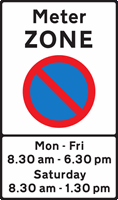
B
C
D
Correct Answer: B
Explanation: Parking restrictions apply in a variety of places and situations. Make sure you know the rules and understand where and when restrictions apply. Controlled parking areas will be indicated by signs and road markings. Parking in the wrong place could cause an obstruction and danger to other traffic. It can also result in a fine
Explanation: Parking restrictions apply in a variety of places and situations. Make sure you know the rules and understand where and when restrictions apply. Controlled parking areas will be indicated by signs and road markings. Parking in the wrong place could cause an obstruction and danger to other traffic. It can also result in a fine
Correct Answer: D
Explanation: Preventing the wheels from locking means that the vehicle's steering and stability can be maintained, leading to safer stopping. However, you must ensure that the engine does not stall, as this could disable the power steering. Look in your vehicle handbook for the correct method when stopping in an emergency.
Explanation: Preventing the wheels from locking means that the vehicle's steering and stability can be maintained, leading to safer stopping. However, you must ensure that the engine does not stall, as this could disable the power steering. Look in your vehicle handbook for the correct method when stopping in an emergency.
36. You are driving a vehicle fitted with anti-lock brakes. You need to stop in an emergency. You should apply the footbrake
Mark one answer
B
C
D
Correct Answer: A
Explanation: Look well ahead down the road as you drive and give yourself time and space to react safely to any hazards. You may have to stop in an emergency due to a misjudgement by another driver or a hazard arising suddenly such as a child running out into the road. In this case, if your vehicle has anti-lock brakes, you should apply the brakes immediately and keep them firmly applied until you stop.
Explanation: Look well ahead down the road as you drive and give yourself time and space to react safely to any hazards. You may have to stop in an emergency due to a misjudgement by another driver or a hazard arising suddenly such as a child running out into the road. In this case, if your vehicle has anti-lock brakes, you should apply the brakes immediately and keep them firmly applied until you stop.
37. Turning the steering wheel while your car is stationary can cause damage to the
Mark two answers
B
C
D
E
Correct Answer: D, E
Explanation: Turning the steering wheel when the car is not moving can cause unnecessary wear to the tyres and steering mechanism. This is known as 'dry' steering.
Explanation: Turning the steering wheel when the car is not moving can cause unnecessary wear to the tyres and steering mechanism. This is known as 'dry' steering.
38. You stop for pedestrians waiting to cross at a zebra crossing. They do not start to cross. What should you do?
Mark one answer
B
C
D
Correct Answer: A
Explanation: If you stop for pedestrians and they don't start to cross don't wave them across or sound your horn. This could be dangerous if another vehicle is approaching which hasn't seen or heard your signal.
Explanation: If you stop for pedestrians and they don't start to cross don't wave them across or sound your horn. This could be dangerous if another vehicle is approaching which hasn't seen or heard your signal.
Correct Answer: D, E
Explanation: Hazard warning lights will warn the traffic travelling behind you that there is a hazard ahead.
Explanation: Hazard warning lights will warn the traffic travelling behind you that there is a hazard ahead.
40. You are on a motorway at night. You MUST have your headlights switched on unless
Mark one answer
B
C
D
Correct Answer: D
Explanation: Always use your headlights at night on a motorway unless you have stopped on the hard shoulder. If you break down and have to stop on the hard shoulder, switch off the headlights but leave the sidelights on so that other road users can see your vehicle.
Explanation: Always use your headlights at night on a motorway unless you have stopped on the hard shoulder. If you break down and have to stop on the hard shoulder, switch off the headlights but leave the sidelights on so that other road users can see your vehicle.
Correct Answer: D
Explanation: The registered keeper of the vehicle is responsible for paying the vehicle excise duty or making a Statutory Off-Road Notification (SORN) if the vehicle is to be kept untaxed and off the road.
Explanation: The registered keeper of the vehicle is responsible for paying the vehicle excise duty or making a Statutory Off-Road Notification (SORN) if the vehicle is to be kept untaxed and off the road.
Correct Answer: A
Explanation: Only use your fog lights when visibility is seriously reduced. Use dipped headlights in poor conditions.
Explanation: Only use your fog lights when visibility is seriously reduced. Use dipped headlights in poor conditions.
43. In which THREE places would parking your vehicle cause danger or obstruction to other road users?
Mark three answers
B
C
D
E
Correct Answer: A, C, D
Explanation: Don't park your vehicle where parking restrictions apply. Think carefully before you slow down and stop. Look at road markings and signs to ensure that you aren't parking illegally.
Explanation: Don't park your vehicle where parking restrictions apply. Think carefully before you slow down and stop. Look at road markings and signs to ensure that you aren't parking illegally.
Correct Answer: A
Explanation: Your brake lights will give an indication to traffic behind that you're slowing down. Good anticipation will allow you time to check your mirrors before slowing.
Explanation: Your brake lights will give an indication to traffic behind that you're slowing down. Good anticipation will allow you time to check your mirrors before slowing.
Correct Answer: C
Explanation: It's illegal to use a hand-held mobile phone while driving, except in genuine emergencies. Even using hands-free kit is very likely to take your mind off your driving. If the use of a mobile causes you to drive in a careless or dangerous manner, you could be prosecuted for those offences. The penalties include an unlimited fine, disqualification and up to two years' imprisonment.
Explanation: It's illegal to use a hand-held mobile phone while driving, except in genuine emergencies. Even using hands-free kit is very likely to take your mind off your driving. If the use of a mobile causes you to drive in a careless or dangerous manner, you could be prosecuted for those offences. The penalties include an unlimited fine, disqualification and up to two years' imprisonment.
46. You are driving in heavy traffic on a wet road. Spray makes it difficult to be seen. You should use your
Mark two answers
B
C
D
E
Correct Answer: A, C
Explanation: You must ensure that you can be seen by others on the road. Use your dipped headlights during the day if the visibility is bad. If you use your rear fog lights, don't forget to turn them off when the visibility improves.
Explanation: You must ensure that you can be seen by others on the road. Use your dipped headlights during the day if the visibility is bad. If you use your rear fog lights, don't forget to turn them off when the visibility improves.
47. You are on a motorway. There is a contraflow system ahead. What would you expect to find?
Mark one answer
B
C
D
Correct Answer: A
Explanation: When approaching a contraflow system reduce speed in good time and obey all speed limits. You may be travelling in a narrower lane than normal with no permanent barrier between you and the oncoming traffic. Be aware that the hard shoulder may be used for traffic and the road ahead could be obstructed by slow-moving or broken down vehicles.
Explanation: When approaching a contraflow system reduce speed in good time and obey all speed limits. You may be travelling in a narrower lane than normal with no permanent barrier between you and the oncoming traffic. Be aware that the hard shoulder may be used for traffic and the road ahead could be obstructed by slow-moving or broken down vehicles.
Correct Answer: C
Explanation: The safest way to carry items on the roof is in a specially designed roof box. This will help to keep your luggage secure and dry, and also has less wind resistance than loads carried on a roof rack.
Explanation: The safest way to carry items on the roof is in a specially designed roof box. This will help to keep your luggage secure and dry, and also has less wind resistance than loads carried on a roof rack.
Correct Answer: A
Explanation: When adult passengers are travelling in a vehicle, it is their own responsibility to wear a seat belt. However, you should still remind them to use a seat belt.
Explanation: When adult passengers are travelling in a vehicle, it is their own responsibility to wear a seat belt. However, you should still remind them to use a seat belt.
Correct Answer: A, D, E
Explanation: Don't venture out if your journey is not necessary. If you have to travel and someone is expecting you at the other end, let them know that you will be taking longer than usual for your journey. This will stop them worrying if you don't turn up on time and will also take the pressure off you, so you don't feel you have to rush.
Explanation: Don't venture out if your journey is not necessary. If you have to travel and someone is expecting you at the other end, let them know that you will be taking longer than usual for your journey. This will stop them worrying if you don't turn up on time and will also take the pressure off you, so you don't feel you have to rush.




